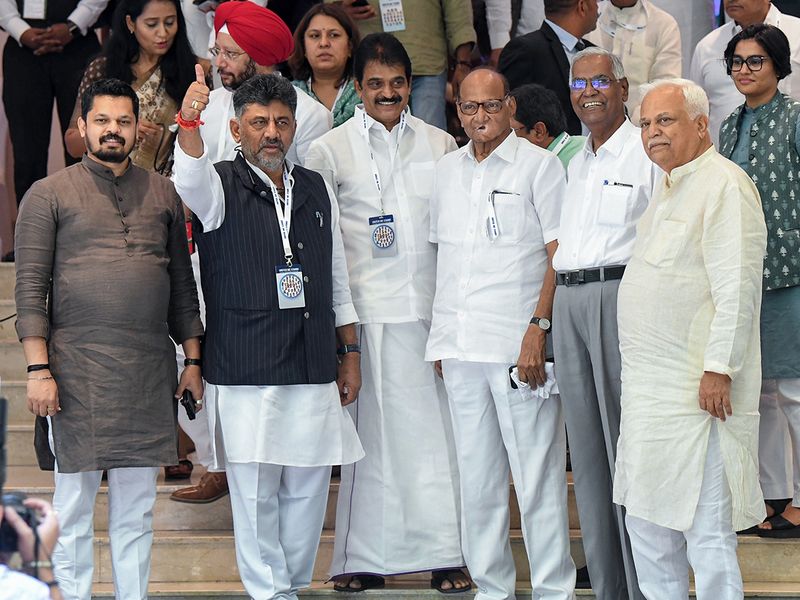
The right face, a narrative that resonates with the masses and a campaign that carries the message door-to-door are the three elements of an election victory.
The efforts for a united national opposition are working towards getting at least one of those three right: the narrative.
From 1989 to 2009, national politics in India used to be called ‘a sum of the states’. That changed in 2014, as Narendra Modi asked voters to think national in a national election and shun the regional.
With this strategy the Bharatiya Janata Party (BJP) won a clear majority in 2014, ending the coalition era. The BJP only increased its seat tally in 2019, again showing how regional forces had become irrelevant in at least the Lok Sabha elections.
Regional parties have thus faced an existential crisis. It’s not easy for them to go to voters in a national election. The voter has been trained by BJP workers to say, ‘But this is a national election. Your regional leader won’t be PM, will he?’
Having a united national opposition front has thus become indispensable. This is how a Trinamool or Samajwadi worker can go to the voter and say, ‘Vote for us. We are part of a national alliance for the national election.’
Opposition unity efforts this time around seem far more serious than 5 years ago. While opposition unity by itself won’t be enough to win the election, it matters in an incremental way.
You see top opposition leaders meet month after month, showing some progress, thus creating a sense of momentum. Something’s happening here that’s no longer easy to brush off.
The way that the Congress accommodated the Aam Aadmi Party shows there’s a serious effort to privilege the national despite the contradictions of the local.
Emotions over numbers
Since 2014, conversations about opposition unity have revolved mostly around statistical ideas to defeat the BJP with the strength of numbers. But politics is not statistics. Politics is emotion.
This time, the idea of Opposition Unity is being forged with ideas first, statistics will follow. While our opposition parties have often been resistant to change, someone clearly felt the need to junk the old “United Progressive Alliance” and have a new name.
That they all agree they need a new name is itself an indicator of great progress: this opposition is humble enough to admit it needs rebranding. UPA must be the most discredited acronym in Indian politics for a decade now. Credit goes here to Sonia Gandhi more than anyone else for agreeing to give up on UPA.
So they all came up with suggestions for a new name, and Mamata Banerjee had the best one. INDIA, or Indian National Developmental Inclusive Alliance. With this smart acronym, the opposition has hit many birds with one stone.
Firstly, they have a catchy name you can’t forget. Secondly, smart acronyms were so far a Narendra Modi way of communication. With INDIA, the opposition shows they can appropriate Modi’s communication style.
Most of all, INDIA seeks to reclaim nationalism from the BJP, and communicates to voters across India that this is a national alliance for national elections, and thus equals the BJP’s national expanse.

INDIA vs. BHARAT?
As soon as the name was announced, Twitter was abuzz with the idea that the BJP will rename its own National Democratic Alliance (NDA) as BHARAT, the official Hindi name for India. The opposition was quick enough to pre-empt this, saying their alliance would have the tagline “Jeetega Bharat” (India will win).
In any case, an INDIA versus BHARAT narrative won’t suit the BJP. It will help consolidate its position in the Hindi heartland, where it already holds almost every seat, but BHARAT would come in the way of the BJP’s efforts to expand outside the Hindi heartland. The BJP will find it hard to counter the name INDIA.
There are reasons why INDIA is a great name. Note that ‘D’ does not stand for Democratic but Developmental. The second ‘I’ stands for Inclusive. Thus the name signifies both social and economic aims.
This is important because the opposition, especially the leading Congress party, needs to give voters a vision for development and economic progress that sounds more appealing than what they have.
Harping on ‘democracy’ and ‘love’ is not going to be enough. “We pledge to present to the nation an alternative, social and economic agenda,” the joint INDIA resolution read.
Once again, working on an agenda for voters before discussing seat-sharing sends the right message, one of being more interested in the people’s progress than grabbing power. It also helps shift the opposition’s image away from having no agenda except Modi-bashing, to actually coming up with policies and programmes for the people’s welfare.
Does BJP even need allies?
The best validation that the opposition is on the right track with INDIA comes from the BJP’s response. They called a meeting of their own allies the same day, making the point that they have 37 regional partners over the Congress party’s 25. This claim of strength only ended up betraying weakness, as most of these 37 parties have no MP in the current Lok Sabha.
Prime Minister Narendra Modi is himself attacking the opposition alliance. The biggest mystery is why the BJP is so worried about the opposition alliance since the BJP has won two Lok Sabha elections in a row with a clear majority and does not need regional coalition partners. In belatedly strengthening the NDA, the BJP is taking no chances, yet also betraying its anxieties.









